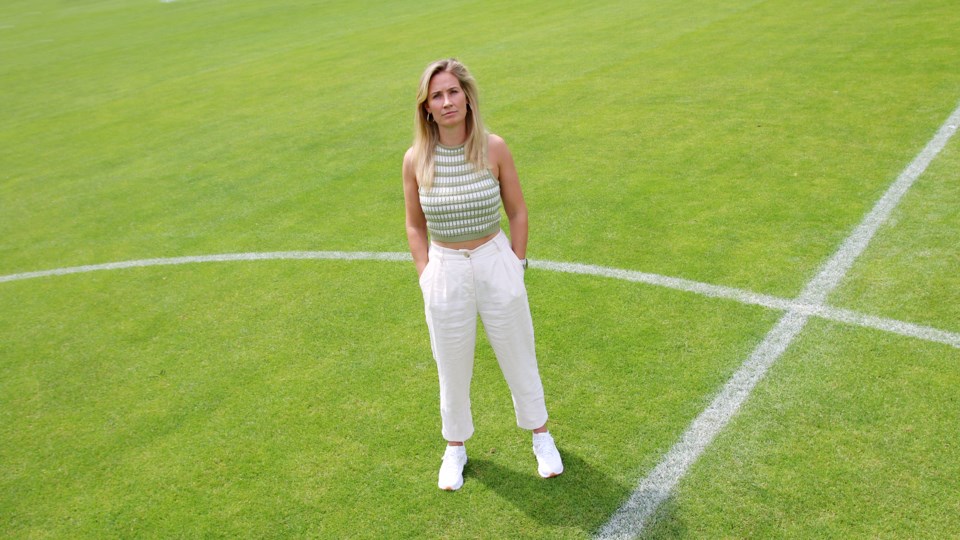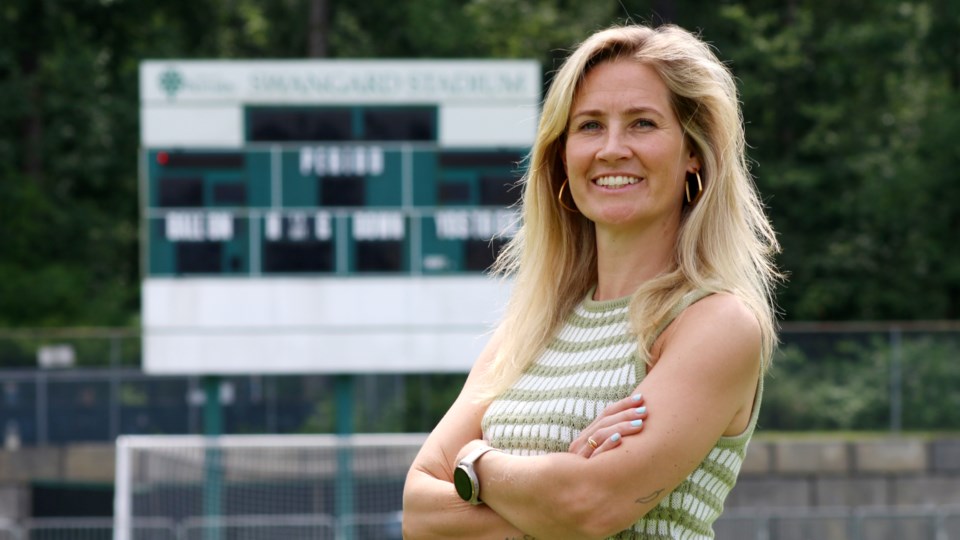Sports fans are seeing women’s professional sports leagues take shape, with two leagues welcoming Vancouver teams this year.
This comes as professional women’s sports teams are on the rise across the continent.
The Canadian women’s professional soccer league Northern Super League (NSL) launched in April, with Vancouver Rise FC as one of its original six teams. Come November, Vancouver will also have a Professional Women’s Hockey League (PWHL) team — an expansion club that has yet to reveal its name.
Both leagues have restraints, such as minimum and maximum salaries, to ensure stability and enable players to be full-time athletes.
They also each have broadcast deals.
Time will tell whether these leagues prosper, or whether they will suffer the fate of now-defunct women’s sports leagues, such as Women’s Professional Soccer (WPS), which ceased operations in 2012 after launching in 2009 with capital from B.C. founding investors Steve Nash and Jeff Mallett.
The National Women’s Soccer League (NWSL) is now the highest-level women’s soccer league in the U.S., where the Women’s National Basketball Association (WNBA) is also turning into a success, setting attendance records and rapidly expanding from its current 13 teams.
A Toronto franchise’s owners paid the WNBA US$115 million to join the league next year, whereas the owners of a franchise in Portland paid US$125 million to join the league, also next year. Three other teams’ owners agreed to pay US$250 million each to join the league in following years.
Women’s professional sports also includes the Pro Volleyball Federation, which is an indoor volleyball league active in the U.S. that launched last year.
Rising fan interest and attendance could make the leagues with Vancouver teams viable. Broadcasters are providing more media coverage while investors are pumping capital into teams and leagues, and sponsors are coming on board.
Challenges remain.
Getting media exposure continues to be a fight, with men’s sports teams continuing to dominate headlines. There is also a perception in some circles that the calibre of play is not as high as it is in men’s leagues. That can hurt attendance.
Vancouver’s PWHL team still sorting business arrangements
Vancouver’s PWHL team is readying for its first-ever game in what will be an expanded eight-team league playing its third season.
The team, which was the league’s first announced expansion team, is entering the PWHL alongside Seattle this fall for a 30-game season, including 15 home matches at the Pacific Coliseum.
U.S.-based Mark Walter Group (MWG) owns the team, as well as the league’s seven other teams and league operations. This creates both stability and risk.
Principal Mark Walter is a billionaire with plenty of sports assets, including a primary stake in the Los Angeles Dodgers and the Los Angeles Lakers. His continued passion for the league is essential, however, given his company’s 100-per-cent ownership.
MWG hired longtime Princeton University women’s hockey coach Cora Gardner Morey to head the Vancouver team’s hockey operations as general manager.
Tania Richards is the Vancouver team’s director of business operations.
Neither was available for an interview, but Richards sent BIV a statement saying that there is “much more to come — from our uniform reveal to partner activations and grassroots programs that will further embed us into the fabric of the Vancouver community.”
Morey has been busy establishing a roster, starting June 4, when a five-day signing window opened for expansion teams to negotiate with free agents and players left unprotected by teams.
Morey hired Brian Idalski as head coach, took part in the PWHL Draft on June 24 and started to make trades.
The league’s YouTube channel streamed the entire draft, while the first three draft rounds were broadcast nationally on TSN.
PWHL broadcast partners TSN, RDS and CBC/Radio-Canada are set to return as Canadian broadcast partners, with Amazon.com Inc.’s Prime Video returning to cover games.
The league has not revealed how much its broadcast deals are worth.
Canadian Tire is a core sponsor for the four Canadian teams, and its logo is on one shoulder of the uniform for those clubs in a sponsorship for which details are not available.
The league’s average salary is about US$55,000 per player, thanks to a US$35,000 minimum salary and a US$80,000 maximum salary.
Last year’s PWHL regular season saw 653,415 fans attend 90 games, which was up nearly 66.6 per cent from 392,259 fans attending 72 games in the league’s inaugural season.
The league’s average attendance last year went to 7,260 from 5,448, up 33 per cent.
Vancouver Rise enjoying solid inaugural season
Vancouver Whitecaps FC’s majority owner Greg Kerfoot was a driving force in creating the NSL, which required each of the six teams to put up a $1 million franchise fee in exchange for an equal stake in the league.
Kerfoot brought in Burnaby-born Canadian soccer legend Christine Sinclair as a minority equity partner, and to be what Rise president Sinead King told BIV is an “ambassador-owner” role with the team.
“At one point, Greg Kerfoot was trying to build a team and get it in the NWSL,” she said. “The NWSL weren’t interested in having a Canadian team, so Canada got to the point of saying, “OK, we’re going to have to do this alone.”
She said Kerfoot joined forces with Calgary Wild co-owner Deanna Zumwalt to be the first two entrepreneurs willing to put up capital to create the league.
“It was originally called Project Eight, because the idea was that they would get eight clubs to start,” King said. “There were six financially sustainable clubs, and we said, ‘Let’s go.’”
She oversees the Rise’s annual budget, which she said exceeds $4 million.
The Rise played its inaugural game in front of 14,018 fans at BC Place April 16, and notched a 1-0 win over the Wild.
The team’s other 11 home games this season are at Burnaby’s Swanguard Stadium, where the first six of those games averaged 2,792 fans.
The NSL’s six teams play either 12 or 13 home games as part of 25-game seasons, King said.
Average ticket prices are about $25, with entry-level pricing at $19 per ticket. Season tickets can be had for between $200 and $400 depending on the seat and number of home games that the club plays, she added.
Another big source of revenue is the league’s $3.5-million broadcast deal with TSN/RDS (Bell Media) and CBC/Radio-Canada.
Dome Productions helps package game broadcasts.
Broadcasters air 25 of the league’s games on TV and their own platforms, and those games are produced using more cameras than are the remaining games, which can be streamed for free on YouTube or on the NSL website, King said.
“Our aspiration is to have everything on broadcast partners,” she added.

Corporate sponsorship provides other needed revenue.
Canadian Tire (TSX:CTC) is a league sponsor, so its brand is on one sleeve of each of the teams’ jerseys, King said.
Telus Corp. (TXS:T) pays the Rise specifically to have its Telus brand on the back of the team’s jerseys, she added.
“We still do not have a front-of-jersey sponsor or a sponsor for the other sleeve,” she said.
League sponsors include companies such as Toyota and WestJet. Toyota provides each team with three vehicles and gets perks such as stadium signage and a brand presence in videos on the league’s website, King said.
WestJet provides preferred flight rates in exchange for being the airline of choice, she added. It also gets stadium signage.
Expenses are significant.
“There’s a $1.6 million salary cap,” she said. “Outside of that, you can have one designated player so your top-paid player would sit outside that cap.”
The league mandates that players earn at least $50,000 per year, King said.
There’s no cap on the budget for coaching, she added.
“Transportation is a big cost,” said King. “Canada is a big country, and being on the West Coast, we have the most miles.”
Men’s professional sports teams often use charter flights but that’s not the case for Rise players, who board regular commercial flights and may more deeply feel the strain of the rigours of travel, King said.
NSL teams tend to have deals with hotel and restaurant chains for discounted rates to keep costs manageable.
Stadium lease costs are “reasonable,” King said, although she would prefer that the team has its own stadium, where it would not need to remove signage and branding after each game.
Kerfoot has floated the idea of building a new stadium on the Pacific National Exhibition grounds that could be used by his Whitecaps for games in Major League Soccer. That team, co-owned by minority owners Mallett, Nash and Steve Luczo is currently up for sale.
The fact that the team does not own its own stadium has led to speculation that a new owner could move the team out of the city.
Office space is another cost for Rise, as the team pays rent for space near BC Place.
The Whitecaps have an office nearby, which can help the team get logistical support and advice.
King said she would like the team to break even within three-to-five years.
Her optimism extends to the league itself.
“The idea is that we’ll expand and add another two teams to be in the league for 2027,” King said.


